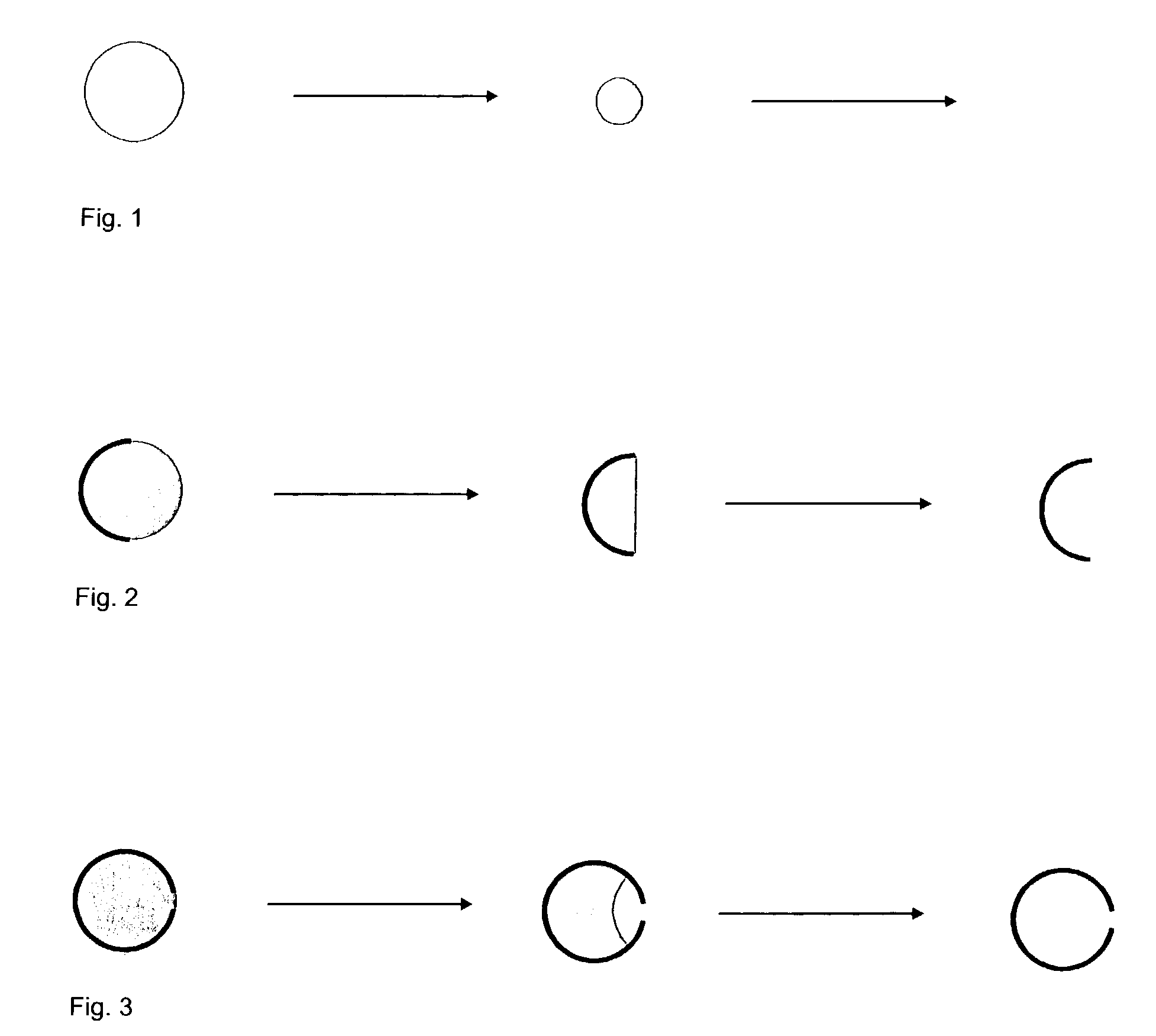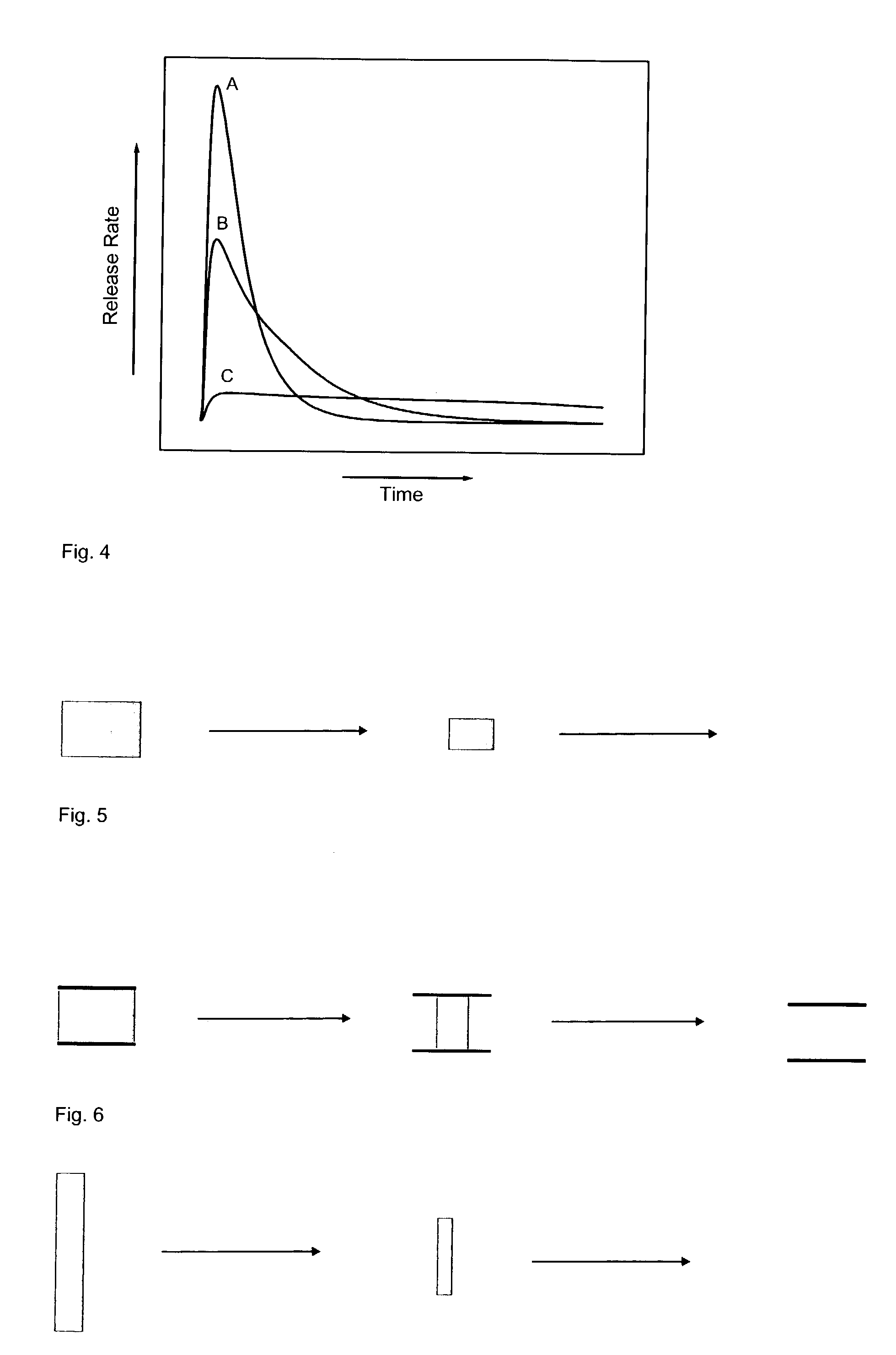Solid dose micro implant
a micro-implant and solid-dose technology, applied in the direction of powder delivery, medical preparations, pharmaceutical delivery mechanisms, etc., can solve the problems of potentially toxic additives or surfactants, drug injected as powder or particles suffers from the same drawbacks, and can not be diluted
- Summary
- Abstract
- Description
- Claims
- Application Information
AI Technical Summary
Problems solved by technology
Method used
Image
Examples
example 1
Release Profiles
[0126] A simple computer simulation on a model for diffusion from different geometries shows the principle of delaying the absorption by coating parts of the surface.
[0127] The model consists of three distinct zones:
[0128] 1. Solid material
[0129] 2. Diffusion layer
[0130] 3. Zone with free flow
[0131] The geometry of the model is arranged so that Zone 1 is completely surrounded by Zone 2 which in turn is completely surrounded by Zone 3. Zone 1 is the drug and the binder on a solid form, for example as a glass. On the surface of Zone 1, the material enters Zone 2 (that is, the material is dissolved) in which it is allowed to diffuse according to Fick's first law of diffusion. Material that enters Zone 3, in which there is free flow, is removed fast and is considered to have been absorbed.
[0132] In the following, a few different situations are considered:
[0133] Firstly, a situation in which the solid material is deposited symmetrically around a centre.
[0134] FIG. 1 shows...
example 2
Manufacture of a Composition
[0145] Extruded Composition Containing 100% Human Insulin
[0146] 1.0 g of insulin is mixed with 1.0 g of water. The mixture was kneaded with a spatula in a glass bottle until homogeneity. The mixture was placed in a Ray-Ran test sample moulder from Ray-Ran Engineering, UK. The mixture was extruded through a 0.5 mm hole. The resulting rods were dried for 24 hours. The compressive strength was tested with an Advanced Force Gauge AFG-250N from Mecmesin, UK. The compressive strength of the rods (diameter 0.5 mm, length 5 mm) was between 2 and 5 N and the rods were therefore not able to penetrate human skin, but had to be administered using a trocar or syringe. The rods were investigated under microscope and air entrapment was observed.
[0147] Extruded Composition Containing 80% Human Insulin and 20% Mannitol
[0148] 0.4 g of mannitol was dissolved in 3.6 g water. 1.6 g of insulin is mixed with the mannitol solution. The mixture was kneaded with a spatula in a gla...
example 3
[0156] A 10% solution of poly lactic acid-glycolic acid copolymer with a lactic acid / glycolic acid ratio in the polymer of 75 / 25 was perpared in methylene chloride. The elongated compositions according to example two were immersed into the solution and left to dry at room temperature. The coating layer had a thickness of 0.14 mm. After dipping and drying, the elongated compositions were cut thereby leaving both ends of the compositions un-coated.
PUM
 Login to View More
Login to View More Abstract
Description
Claims
Application Information
 Login to View More
Login to View More - R&D
- Intellectual Property
- Life Sciences
- Materials
- Tech Scout
- Unparalleled Data Quality
- Higher Quality Content
- 60% Fewer Hallucinations
Browse by: Latest US Patents, China's latest patents, Technical Efficacy Thesaurus, Application Domain, Technology Topic, Popular Technical Reports.
© 2025 PatSnap. All rights reserved.Legal|Privacy policy|Modern Slavery Act Transparency Statement|Sitemap|About US| Contact US: help@patsnap.com



